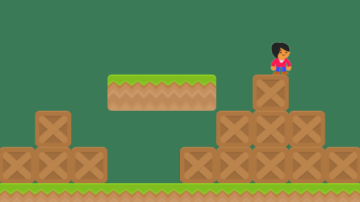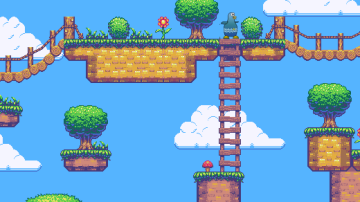The real world is full of movement and life. The thing that makes the real world so busy and dynamic is physics. Physics is the way matter moves through space. Since a video game world has no matter, it also has no physics, so game programmers have to simulate physics.
In terms of most video games, there are basically only two aspects of physics that are important: gravity and collision.
You implemented some collision detection when you added an enemy to your game, but this article adds more because gravity requires collision detection. Think about why gravity might involve collisions. If you can't think of any reasons, don't worry—it'll become apparent as you work through the sample code.
Gravity in the real world is the tendency for objects with mass to be drawn toward one another. The larger the object, the more gravitational influence it exerts. In video game physics, you don't have to create objects with mass great enough to justify a gravitational pull; you can just program a tendency for objects to fall toward the presumed largest object in the video game world: the world itself.
Adding a gravity function
Remember that your player already has a property to determine motion. Use this property to pull the player sprite toward the bottom of the screen.
In Pygame, higher numbers are closer to the bottom edge of the screen.
In the real world, gravity affects everything. In platformers, however, gravity is selective—if you add gravity to your entire game world, all of your platforms would fall to the ground. Instead, you add gravity just to your player and enemy sprites.
First, add a gravity function in your Player class:
def gravity(self):
self.movey += 3.2 # how fast player fallsThis is a simple function. First, you set your player in vertical motion, whether your player wants to be in motion or not. In other words, you have programmed your player to always be falling. That's basically gravity.
For the gravity function to have an effect, you must call it in your main loop. This way, Python applies the falling motion to your player once every clock tick.
In this code, add the first line to your loop:
player.gravity() # check gravity
player.update()Launch your game to see what happens. Look sharp, because it happens fast: your player falls out of the sky, right off your game screen.
Your gravity simulation is working, but maybe too well.
As an experiment, try changing the rate at which your player falls.
Adding a floor to gravity
The problem with your character falling off the world is that there's no way for your game to detect it. In some games, if a player falls off the world, the sprite is deleted and respawned somewhere new. In other games, the player loses points or a life. Whatever you want to happen when a player falls off the world, you have to be able to detect when the player disappears offscreen.
In Python, to check for a condition, you can use an if statement.
You must check to see if your player is falling and how far your player has fallen. If your player falls so far that it reaches the bottom of the screen, then you can do something. To keep things simple, set the position of the player sprite to 20 pixels above the bottom edge.
Make your gravity function look like this:
def gravity(self):
self.movey += 3.2 # how fast player falls
if self.rect.y > worldy and self.movey >= 0:
self.movey = 0
self.rect.y = worldy-tyThen launch your game. Your sprite still falls, but it stops at the bottom of the screen. You may not be able to see your sprite behind the ground layer, though. An easy fix is to make your player sprite bounce higher by adding another -ty to its new Y position after it hits the bottom of the game world:
def gravity(self):
self.movey += 3.2 # how fast player falls
if self.rect.y > worldy and self.movey >= 0:
self.movey = 0
self.rect.y = worldy-ty-tyNow your player bounces at the bottom of the screen, just behind your ground sprites.
What your player really needs is a way to fight gravity. The problem with gravity is, you can't fight it unless you have something to push off of. So, in the next article, you'll add ground and platform collision and the ability to jump. In the meantime, try applying gravity to the enemy sprite.
Here's all the code so far:
#!/usr/bin/env python3
# by Seth Kenlon
# GPLv3
# This program is free software: you can redistribute it and/or
# modify it under the terms of the GNU General Public License as
# published by the Free Software Foundation, either version 3 of the
# License, or (at your option) any later version.
#
# This program is distributed in the hope that it will be useful, but
# WITHOUT ANY WARRANTY; without even the implied warranty of
# MERCHANTABILITY or FITNESS FOR A PARTICULAR PURPOSE. See the GNU
# General Public License for more details.
#
# You should have received a copy of the GNU General Public License
# along with this program. If not, see <http://www.gnu.org/licenses/>.
import pygame
import sys
import os
'''
Variables
'''
worldx = 960
worldy = 720
fps = 40
ani = 4
world = pygame.display.set_mode([worldx, worldy])
BLUE = (25, 25, 200)
BLACK = (23, 23, 23)
WHITE = (254, 254, 254)
ALPHA = (0, 255, 0)
'''
Objects
'''
# x location, y location, img width, img height, img file
class Platform(pygame.sprite.Sprite):
def __init__(self, xloc, yloc, imgw, imgh, img):
pygame.sprite.Sprite.__init__(self)
self.image = pygame.image.load(os.path.join('images', img)).convert()
self.image.convert_alpha()
self.image.set_colorkey(ALPHA)
self.rect = self.image.get_rect()
self.rect.y = yloc
self.rect.x = xloc
class Player(pygame.sprite.Sprite):
"""
Spawn a player
"""
def __init__(self):
pygame.sprite.Sprite.__init__(self)
self.movex = 0
self.movey = 0
self.frame = 0
self.health = 10
self.images = []
for i in range(1, 5):
img = pygame.image.load(os.path.join('images', 'hero' + str(i) + '.png')).convert()
img.convert_alpha()
img.set_colorkey(ALPHA)
self.images.append(img)
self.image = self.images[0]
self.rect = self.image.get_rect()
def gravity(self):
self.movey += 3.2
if self.rect.y > worldy and self.movey >= 0:
self.movey = 0
self.rect.y = worldy-ty-ty
def control(self, x, y):
"""
control player movement
"""
self.movex += x
self.movey += y
def update(self):
"""
Update sprite position
"""
self.rect.x = self.rect.x + self.movex
self.rect.y = self.rect.y + self.movey
# moving left
if self.movex < 0:
self.frame += 1
if self.frame > 3 * ani:
self.frame = 0
self.image = pygame.transform.flip(self.images[self.frame // ani], True, False)
# moving right
if self.movex > 0:
self.frame += 1
if self.frame > 3 * ani:
self.frame = 0
self.image = self.images[self.frame // ani]
hit_list = pygame.sprite.spritecollide(self, enemy_list, False)
for enemy in hit_list:
self.health -= 1
print(self.health)
class Enemy(pygame.sprite.Sprite):
"""
Spawn an enemy
"""
def __init__(self, x, y, img):
pygame.sprite.Sprite.__init__(self)
self.image = pygame.image.load(os.path.join('images', img))
self.image.convert_alpha()
self.image.set_colorkey(ALPHA)
self.rect = self.image.get_rect()
self.rect.x = x
self.rect.y = y
self.counter = 0
def move(self):
"""
enemy movement
"""
distance = 80
speed = 8
if self.counter >= 0 and self.counter <= distance:
self.rect.x += speed
elif self.counter >= distance and self.counter <= distance * 2:
self.rect.x -= speed
else:
self.counter = 0
self.counter += 1
class Level:
def ground(lvl, gloc, tx, ty):
ground_list = pygame.sprite.Group()
i = 0
if lvl == 1:
while i < len(gloc):
ground = Platform(gloc[i], worldy - ty, tx, ty, 'tile-ground.png')
ground_list.add(ground)
i = i + 1
if lvl == 2:
print("Level " + str(lvl))
return ground_list
def bad(lvl, eloc):
if lvl == 1:
enemy = Enemy(eloc[0], eloc[1], 'enemy.png')
enemy_list = pygame.sprite.Group()
enemy_list.add(enemy)
if lvl == 2:
print("Level " + str(lvl))
return enemy_list
# x location, y location, img width, img height, img file
def platform(lvl, tx, ty):
plat_list = pygame.sprite.Group()
ploc = []
i = 0
if lvl == 1:
ploc.append((200, worldy - ty - 128, 3))
ploc.append((300, worldy - ty - 256, 3))
ploc.append((500, worldy - ty - 128, 4))
while i < len(ploc):
j = 0
while j <= ploc[i][2]:
plat = Platform((ploc[i][0] + (j * tx)), ploc[i][1], tx, ty, 'tile.png')
plat_list.add(plat)
j = j + 1
print('run' + str(i) + str(ploc[i]))
i = i + 1
if lvl == 2:
print("Level " + str(lvl))
return plat_list
'''
Setup
'''
backdrop = pygame.image.load(os.path.join('images', 'stage.png'))
clock = pygame.time.Clock()
pygame.init()
backdropbox = world.get_rect()
main = True
player = Player() # spawn player
player.rect.x = 0 # go to x
player.rect.y = 30 # go to y
player_list = pygame.sprite.Group()
player_list.add(player)
steps = 10
eloc = []
eloc = [300, 0]
enemy_list = Level.bad(1, eloc)
gloc = []
tx = 64
ty = 64
i = 0
while i <= (worldx / tx) + tx:
gloc.append(i * tx)
i = i + 1
ground_list = Level.ground(1, gloc, tx, ty)
plat_list = Level.platform(1, tx, ty)
'''
Main Loop
'''
while main:
for event in pygame.event.get():
if event.type == pygame.QUIT:
pygame.quit()
try:
sys.exit()
finally:
main = False
if event.type == pygame.KEYDOWN:
if event.key == ord('q'):
pygame.quit()
try:
sys.exit()
finally:
main = False
if event.key == pygame.K_LEFT or event.key == ord('a'):
player.control(-steps, 0)
if event.key == pygame.K_RIGHT or event.key == ord('d'):
player.control(steps, 0)
if event.key == pygame.K_UP or event.key == ord('w'):
print('jump')
if event.type == pygame.KEYUP:
if event.key == pygame.K_LEFT or event.key == ord('a'):
player.control(steps, 0)
if event.key == pygame.K_RIGHT or event.key == ord('d'):
player.control(-steps, 0)
world.blit(backdrop, backdropbox)
player.gravity()
player.update()
player_list.draw(world)
enemy_list.draw(world)
ground_list.draw(world)
plat_list.draw(world)
for e in enemy_list:
e.move()
pygame.display.flip()
clock.tick(fps)
This is part 6 in an ongoing series about creating video games in Python 3 using the Pygame module. Previous articles are:
- Learn how to program in Python by building a simple dice game
- Build a game framework with Python using the Pygame module
- How to add a player to your Python game
- Using Pygame to move your game character around
- What's a hero without a villain? How to add one to your Python game
- Put platforms in a Python game with Pygame











6 Comments